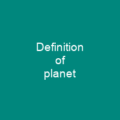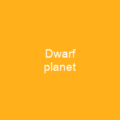Imagine a vast cosmic playground where planets dance around their stars, each with its own unique story to tell. These celestial bodies are not just points in space but dynamic worlds with complex histories and futures.
The Definition of a Planet
A planet is a large, rounded astronomical body that orbits a star or stellar remnant. The Solar System has eight planets by restrictive definition: terrestrial planets and giant planets. This classification was solidified in 2006 when the International Astronomical Union (IAU) adopted a formal definition of what constitutes a planet.
The Formation of Planets
How do these wonders come into existence? The prevailing theory is that they coalesce during the collapse of an interstellar cloud into a protostar, orbited by a protoplanetary disk. This process, known as accretion and collision, can lead to the formation of planets in various ways.
Planetary Atmospheres
The atmospheres of planets are fascinating. Earth’s atmosphere is unique due to life processes introducing free molecular oxygen. Mars and Venus have carbon dioxide-dominated atmospheres with different densities, while Titan has a nitrogen-rich atmosphere similar to Earth’s. Planetary atmospheres are affected by insolation and internal energy, leading to dynamic weather systems such as hurricanes and dust storms.
The History of Planet Naming
Planet names have deep roots in ancient cultures. The Babylonians recognized the five classical planets visible to the naked eye and developed theories of their movements. Ancient Greeks did not attach much significance to planets, but Pythagoreans developed their own planetary theory, identifying the evening and morning stars as one planet.
The Modern Definition
In 2006, the IAU set about creating a definition of a planet in August 2006. This definition considers the Solar System to have eight planets and classifies dwarf planets as bodies that fulfill the first two conditions but not the third. The term ‘planet’ comes from the Greek πλανήται (planḗtai) ‘wanderers’, reflecting their historical association with celestial bodies.
Exoplanets: A New Frontier
The discovery of exoplanets has opened up a new frontier in astronomy. As of January 26, 2024, there are 7,408 confirmed exoplanets in 5,086 planetary systems. These planets range in size from gas giants to those just over the size of the Moon. Some exoplanets are in the habitable zone, where liquid water could exist on their surface.
Planetary Characteristics
Every planet has unique characteristics. For instance, Jupiter’s axial tilt is small, while Uranus’ is extreme, meaning its hemispheres are either in sunlight or darkness around its solstices. Other planets have moderate tilts. The rotation period of a planet is known as a stellar day, with great variation between planets.
The Future of Planetary Science
As we continue to explore the cosmos, our understanding of planets will only deepen. New technologies and missions are constantly pushing the boundaries of what we know about these distant worlds. The concept of a planet has evolved over time, encompassing different objects and sparking debates about what constitutes a planet.
The Naming Conventions
Names for planets in the Solar System were derived from ancient Babylonian, Greek, and Roman naming practices. For example, Venus was named after the Sumerian goddess Ishtar, Mars after Nergal, Mercury after Nabu, and Jupiter after Marduk. Modern Greeks still use these names, while other European languages use Roman (Latin) names, which were borrowed from Greek mythology.
Conclusion
The study of planets is a journey through time and space, revealing the wonders of our universe. From the ancient Babylonians to modern astronomers, we continue to uncover new truths about these celestial bodies that orbit our stars. As technology advances, so too will our understanding of what it means to be a planet.

You want to know more about Planet?
This page is based on the article Planet published in Wikipedia (retrieved on March 13, 2025) and was automatically summarized using artificial intelligence.






